The Floor Heave Mechanism and Control Technology of Gob-Side Entry Retaining of Soft Rock Floor
Abstract
:1. Introduction
2. Background


3. Analysis of Floor Heave Mechanism of Roadway
3.1. Stress Distribution Law of Gob-Side Entry Retaining Being Affected by Stoping
3.2. Mechanical Analysis of the Floor Heave Mechanism of Gob-Side Entry Retaining
4. Floor Heave Control Technology
4.1. Pressure Relief Mechanism of Floor Loosening Blasting
4.2. Research on Loosening Blasting Parameters
5. Field Measurement and Analysis
6. Discussion
7. Conclusions
- (1)
- The floor was a weak stratum, and the roof was a thick and hard sandstone layer for the auxiliary transportation roadway of the N2301 working face of the Ancient City Coal Mine. The roadway in front of the working face was affected by the horizontal stress and lead abutment pressure of the floor. The vertical stress of entry retaining in the rear of the working face accumulated in large quantities in solid coal of the two sides and the filling body of entry retaining. Moreover, the solid coal side had a larger concentration and influence range than the filling body side. The floor was affected by the vertical stress of the two sides.
- (2)
- The floor heave of entry retaining was caused by concentrated vertical stress in the solid coal and filling body of two sides. The floor was squeezed by the two sides to form an asymmetric sliding force towards the free face of the floor. Moreover, sliding force increased with the increased vertical stress of the two sides. The deviation degree between the effective sliding force and the position of the roadway floor also increased with the increased vertical stress difference between the two sides of the roadway. The weaker floor led to a smaller converted friction angle. Furthermore, the vertical stress of the two sides had more significant extrusion characteristics on the rock body of the floor.
- (3)
- A weakening area of surrounding rocks was formed based on the floor heave control technology of “pressure relief by floor loosening blasting and pressure relief by gob-side roof cutting”. The stress concentration areas of roadway floor and two sides were transferred to deep surrounding rocks. The vertical stress in the solid coal and filling body of two sides was reduced to decrease the resultant sliding force acting on the roadway floor.
- (4)
- The roadway within 100 m in the rear of the working face had a high speed of floor heave, which gradually slowed down when the distance was larger than 100 m. Floor heave decreased to 168 mm after adopting “floor loosening blasting and pressure relief by roof cutting” at 250 m in the rear of the working face. Floor heave was well controlled. The research findings can furnish a more scientifically sound theoretical foundation for controlling floor heave in gob-side entry retaining, thus providing a fundamental guarantee and impetus for the sustainable advancement of gob-side entry retaining technology in coal mining.
Author Contributions
Funding
Institutional Review Board Statement
Informed Consent Statement
Data Availability Statement
Acknowledgments
Conflicts of Interest
References
- Zhou, X.M.; Wang, S.; Li, X.L. Research on Theory and Technology of Floor Heave Control in Semicoal Rock Roadway: Taking Longhu Coal Mine in Qitaihe Mining Area as an Example. Lithosphere 2022, 2022, 3810988. [Google Scholar] [CrossRef]
- Yang, H.Z.; Wang, D.P.; Ju, W.J. Asymmetric Damage Mechanisms and Prevention Technology in Large-Section Gob-Side Entry Retaining. Sustainability 2023, 15, 739. [Google Scholar] [CrossRef]
- Yuan, S.C.; Zheng, G.S.; Qian, Z.W. Research on water and sand inrush mechnism and repair technology of shaft rupture in inclined shaft. Coal Sci. Technol. 2019, 47, 113–118. [Google Scholar]
- Yang, H.Q.; Zhang, N.; Han, C.L. Stability Control of Deep Coal Roadway under the Pressure Relief Effect of Adjacent Roadway with Large Deformation: A Case Study. Sustainability 2021, 13, 4412. [Google Scholar] [CrossRef]
- Hu, C.W.; Yang, X.J.; Huang, R.F. Presplitting Blasting the Roof Strata to Control Large Deformation in the Deep Mine Roadway. Adv. Civ. Eng. 2020, 2020, 1449–1462. [Google Scholar] [CrossRef]
- Yuan, S.C.; Han, G.L. Combined drilling methods to install grout curtains in a deep underground mine: A case study in southwest china. Mine Water Environ. 2020, 39, 902–909. [Google Scholar] [CrossRef]
- Lai, X.; Xu, H.; Shan, P. Research on Mechanism and Control of Floor Heave of Mining-Influenced Roadway in Top Coal Caving Working Face. Energies 2020, 13, 381. [Google Scholar] [CrossRef] [Green Version]
- Wu, J.X.; Fang, S.L. Mechanical mechanism and control technology of floor heave of high stress thick coal seam under dynamic pressure. Coal Sci. Technol. 2018, 12, 86–91. [Google Scholar] [CrossRef]
- Li, J.B.; Yi, S.X. Study on deformation and rock failure mechanism of floor rock mass with thin aquifuge near Ordovician limestone. Coal Sci. Technol. 2021, 12, 173–179. [Google Scholar]
- Zhang, K.X.; Ma, Z.Q.; Yang, Y.M. Technology of Floor Heave Prevention and Control in Fully-Mechanized Thick Seam Top Coal Caving Mining Face with High Intensity Mining. Coal Sci. Technol. 2014, 11, 33–36. [Google Scholar]
- Gao, X.X.; Guo, Y.; Qiao, Z.Q. Research on Control Technology of Roadway Floor Heave in Daliuta Coal Mine. Min. Res. Dev. 2021, 9, 45–68. [Google Scholar]
- Fan, G.T.; Zhang, D.D.; Zhang, L.J. Research on Floor Heave Mechanism and Control of Mining Roadway in Fully Mechanized Mining Face with Deep Depth and Large Mining Height. Min. Res. Dev. 2022, 5, 95–100. [Google Scholar]
- Yang, R.S.; Zhu, Y.; Li, Y.L. Floor heave mechanism and control measures of layered floor in weakly cemented soft rock roadway. J. Min. Saf. Eng. 2020, 3, 443–450. [Google Scholar]
- Zhang, G.Y.; Zhao, L.; Shnag, Y.Q. Study on key control technology of floor heave in soft rock roadway. Coal Sci. Technol. 2019, 11, 63–67. [Google Scholar]
- Yang, R.S.; Li, Y.L.; Guo, D.M. Deformation reasons and support technology of deep and high-stress soft rock roadway. J. Min. Saf. Eng. 2017, 6, 1035–1041. [Google Scholar]
- Sun, L.H.; Yang, B.S.; Sun, C.D. Experimental research on mechanism and controlling of floor heave in deep soft rock roadway. J. Min. Saf. Eng. 2017, 2, 235–242. [Google Scholar]
- Lu, J.; Gong, P.L.; Li, P. Research on the Mechanism of Floor Heave and Borehole Pressure Relief Technology in Deep Soft Rock Roadway. Min. Saf. Environ. Prot. 2019, 6, 35–41. [Google Scholar]
- Gao, L.S.; Zheng, X.J.; Wang, Y.C. Study on mechanism of pressure relief by deep hole blasing and technique system to control floor heave on the roadway floor. China Min. Mag. 2020, 8, 104–110. [Google Scholar]
- Zhang, C.S. Surrounding Rock Control Technology of Roadway Adjacen Goaf in Fully Mechanized Large Height Mining Face. Coal Sci. Technol. 2013, 41, 6–7. [Google Scholar]
- Wang, Z.Q.; Wang, P.; Lv, W.Y. Mechanism and control of asymmetric floor heave in gob-side entry. J. Min. Saf. Eng. 2021, 2, 335–346. [Google Scholar]
- Zhai, X.X.; Qin, L.T.; Chen, C.Y. Combined Supporting Technology of Anchoring and Grouting and Floor Relief in Deep Chamber of Belt Conveyor. Chin. J. Undergr. Space Eng. 2017, 5, 1363–1372. [Google Scholar]
- Yu, G.Y.; Wang, J.; Sun, H. Mechanism and comprehensive control techniques for large deformation of floor heave in block filling gob-side entry retaining. J. Min. Saf. Eng. 2022, 2, 335–346. [Google Scholar]
- Qin, X.H.; Zhang, Y.H.; Wang, J.J. Experimental Study on Floor Heave Mechanism of Soft Rock Roadway Based on Numerical Simulation. Min. Res. Dev. 2019, 9, 51–56. [Google Scholar]
- Zhao, H.B.; Liu, Y.H.; Cheng, H. Mechanism and prevention measures of asymmetric floor heave in mining roadway of Huipodi Coal Mine. J. Min. Sci. Technol. 2020, 6, 638–647. [Google Scholar]
- Zhang, W.K.; Liu, D.L.; Sun, D.Z. Failure mechanism and active control technology of deep roadway in Chengjiao Coal Mine. Min. Saf. Environ. Prot. 2020, 3, 76–81. [Google Scholar]
- Jing, H.H.; Sun, X.M.; Heng, C.Y. Study on compound support technology for mining gateway in tilted strata in deep mine. Coal Sci. Technol. 2001, 8, 24–26. [Google Scholar]
- Zhang, C.; Bai, Q.S.; Han, P.H. Strength Weakening and its Micromechanism in Water–rock Interaction, a Short Review in Laboratory Tests. Int. J. Coal Sci. Technol. 2023, 10, 10. [Google Scholar] [CrossRef]
- Han, P.H.; Zhang, C.; Wang, X.J. Study of Mechanical Characteristics and Damage Mechanism of Sandstone under Long-term Immersion. Eng. Geol. 2023, 10, 107020. [Google Scholar] [CrossRef]
- Qian, M.G.; Shi, P.W.; Xu, J.L. Ground Pressure and Strata Control; China University of Mining and Technology Press: Xuzhou, China, 2010. [Google Scholar]
- Wu, S.G. Soil Mechanics; Chongqing University Press: Chongqing, China, 2016. [Google Scholar]
- Li, T.L. Mine Rock Mechanics; Chongqing University Press: Chongqing, China, 1991. [Google Scholar]
- Hou, C.J. Tunnel Surrounding Rock Control; China University of Mining and Technology Press: Xuzhou, China, 2010. [Google Scholar]
- Cao, Z.A.; Liu, Y.M.; Gao, M.S. Study on Downward Borehole Bolt and Grouting Reinforcement Technology of Mine Soft and Weak Mudstone Roadway Floor. Coal Sci. Technol. 2016, 44, 12–17. [Google Scholar]
- Li, S.B.; Fan, H.; Liu, W.R. Techniques and Principle of Floor Heave Controlling of Soft Rock Roadway in Deep. Coal Mining Technology 2016, 21, 78–80+42. [Google Scholar]
- Chang, J.C.; He, L.P. A Research on Cable Supporting and Curtain Grouting of Hydraulic Hose Controlling the Roadway Floor Heave in Deep Coal Mine. J. Min. Saf. Eng. 2015, 32, 968–972. [Google Scholar]
- Yu, W.J.; Wang, W.J.; Huang, W.Z. Deformation Mechanism and Rework Control Technology of High Stress and Soft Rock Roadway. J. China Coal Soc. 2014, 39, 614–623. [Google Scholar]
- Wang, C.; Wu, Y.P.; Huang, X.P. Mechanism of floor failure of roadway supported by inverted arch under complicated surrounding rocks and its control. J. Min. Saf. Eng. 2018, 36, 959–967+976. [Google Scholar]
- Jing, L.W.; Yan, Y. Mechanism and Control Technology of Floor Heave in High Stress Soft Rock Chamber. Coal Eng. 2022, 54, 112–117. [Google Scholar]
- Mu, C.Y.; Ma, Z. Deformation Mechanism Analysis and Supporting Technology for Rock Roadway Floor Heave Under Deep Complex Geological Condition. Saf. Coal Mines 2016, 47, 95–98. [Google Scholar]




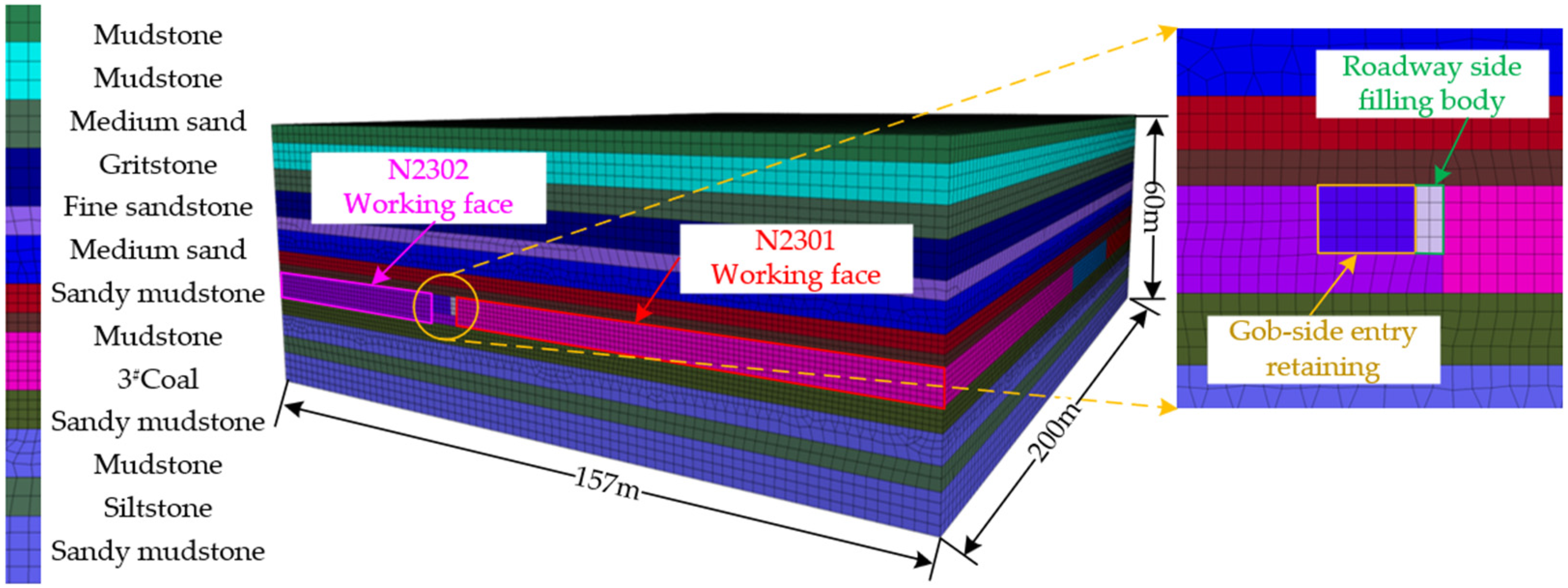




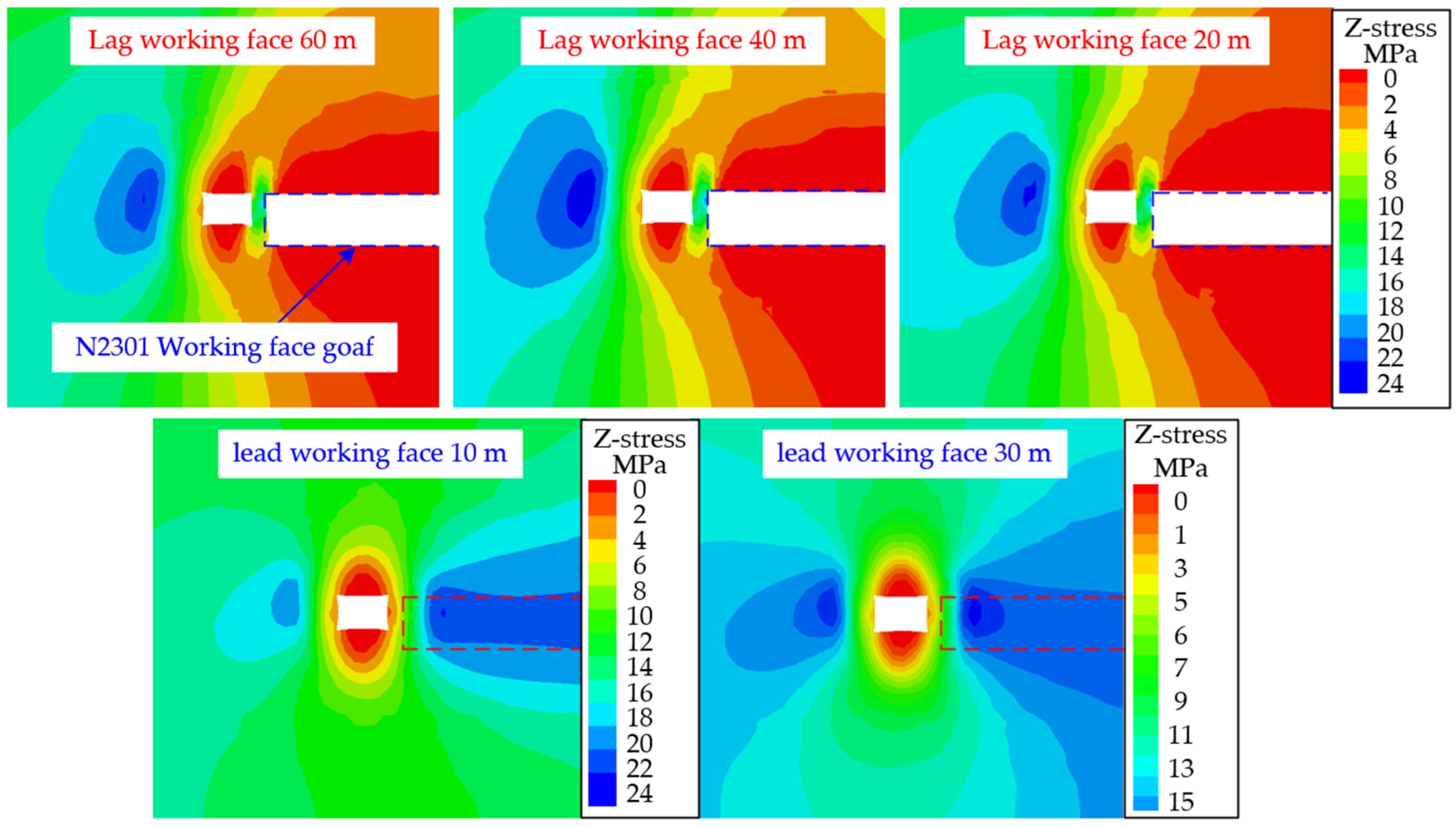
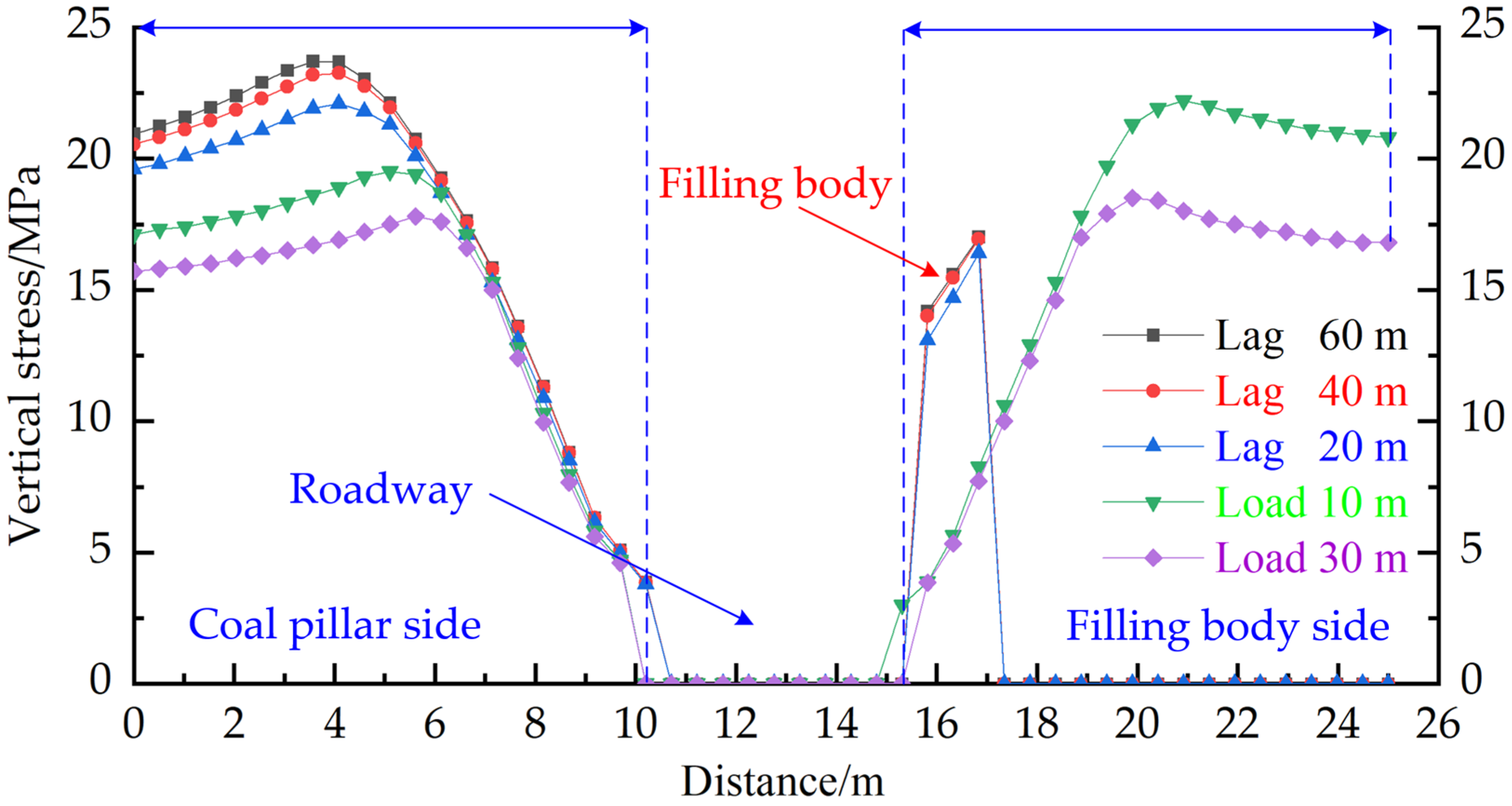
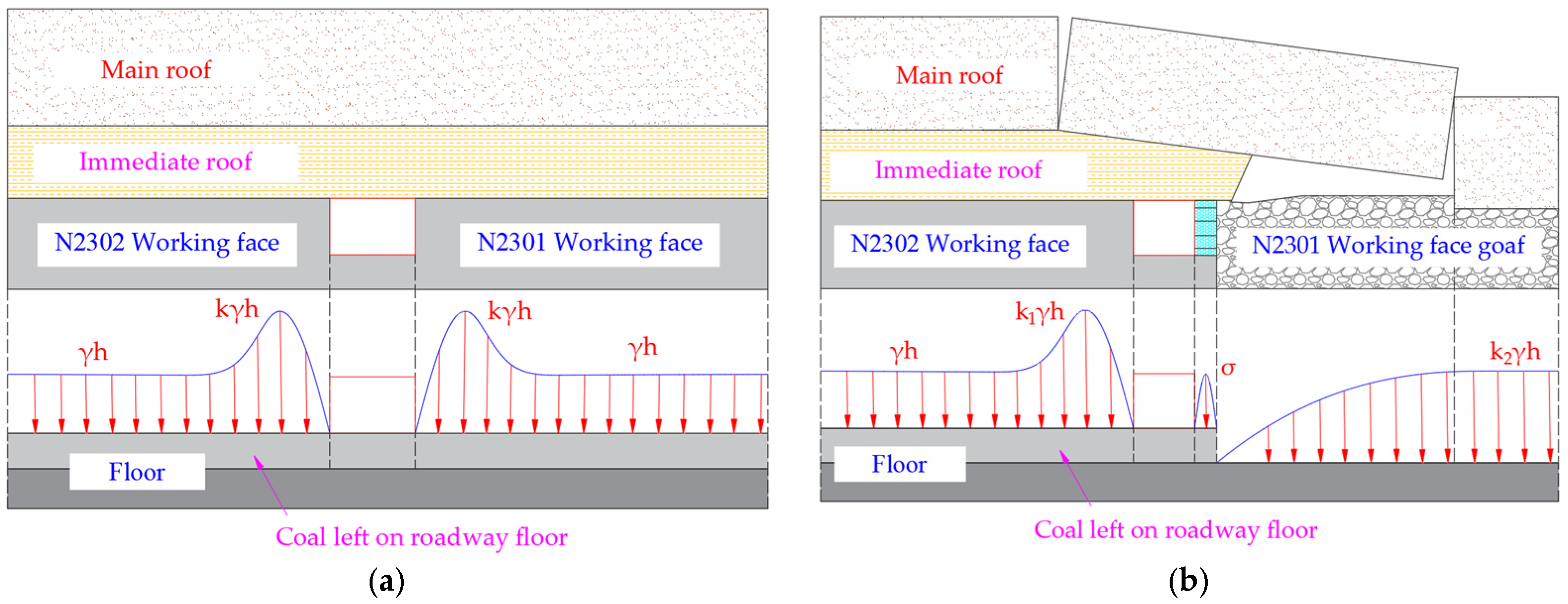









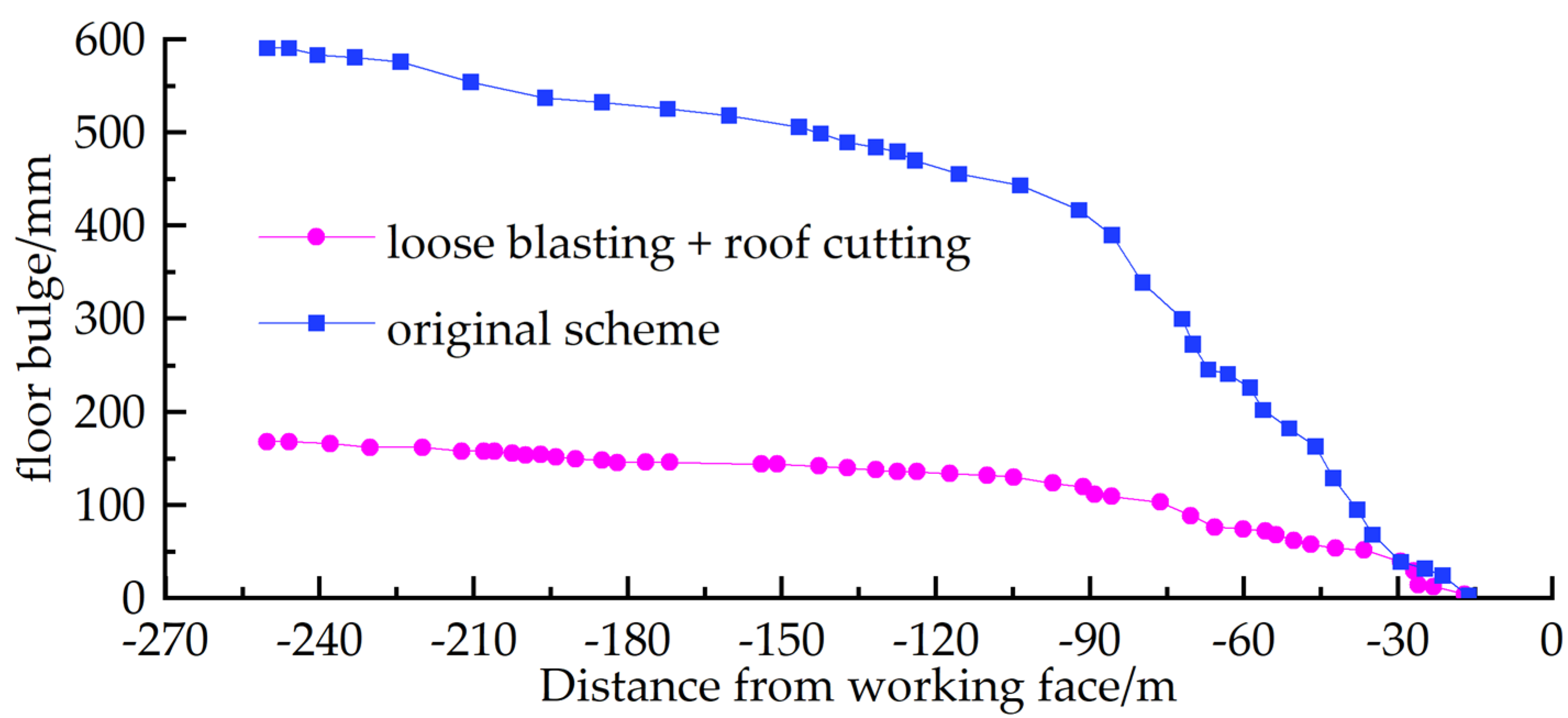
| Position | Blast Hole Length/m | Spacing/m | Row Spacing/m | Angle/(°) | Hole Sealing Length/m | Loaded Length/m | Blast Hole Diameter/mm | Cartridge Diameter /mm | No. of Cartridges/PCS | Explosive Load/kg | Initiation Manner |
|---|---|---|---|---|---|---|---|---|---|---|---|
| Floor | 10 | 4.3 | 4 | 45 | 8.24 | 1.76 | 55 | 45 | 4 | 3.2 | Forward blasting |
Disclaimer/Publisher’s Note: The statements, opinions and data contained in all publications are solely those of the individual author(s) and contributor(s) and not of MDPI and/or the editor(s). MDPI and/or the editor(s) disclaim responsibility for any injury to people or property resulting from any ideas, methods, instructions or products referred to in the content. |
© 2023 by the authors. Licensee MDPI, Basel, Switzerland. This article is an open access article distributed under the terms and conditions of the Creative Commons Attribution (CC BY) license (https://creativecommons.org/licenses/by/4.0/).
Share and Cite
Li, Z.; Zhang, Y.; Ma, Q.; Zheng, Y.; Song, G.; Yan, W.; Zhang, Y.; Hu, L. The Floor Heave Mechanism and Control Technology of Gob-Side Entry Retaining of Soft Rock Floor. Sustainability 2023, 15, 6074. https://doi.org/10.3390/su15076074
Li Z, Zhang Y, Ma Q, Zheng Y, Song G, Yan W, Zhang Y, Hu L. The Floor Heave Mechanism and Control Technology of Gob-Side Entry Retaining of Soft Rock Floor. Sustainability. 2023; 15(7):6074. https://doi.org/10.3390/su15076074
Chicago/Turabian StyleLi, Zexin, Yidong Zhang, Qi Ma, Yu Zheng, Guangyuan Song, Wanzi Yan, Yu Zhang, and Lei Hu. 2023. "The Floor Heave Mechanism and Control Technology of Gob-Side Entry Retaining of Soft Rock Floor" Sustainability 15, no. 7: 6074. https://doi.org/10.3390/su15076074




